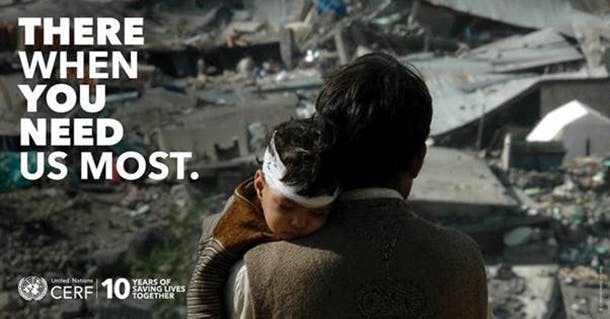
Right now, millions of families around the world have been devastated by conflict and disaster and are in need of humanitarian assistance – from food to health services. A vital element of the global humanitarian response system is the United Nations Central Emergency Response Fund (CERF), which helps get resources where they are needed most.
We recently had a chance to ask CERF’s Chief Lisa Doughten about the Fund and why it matters.
What should people know about CERF?
Established as “a fund for all, by all,” CERF enables the international community to assist the world’s most vulnerable people wherever and whenever a crisis occurs. It is one of the fastest and most effective ways to support rapid response for people affected by humanitarian crises.
Today CERF has become indispensable to global humanitarian response. It provides UN organizations and their partners with flexible and timely funds to kick start relief efforts immediately.
CERF-funded projects are selected based on impartial assessments of needs conducted by humanitarian teams on the ground. The funds flow to a vast network of partners, supporting a coordinated response. With CERF funds, responders are able to quickly procure and deliver large amounts of relief supplies for the most vulnerable.
What has CERF accomplished in the past 10 years to help improve lives of people who have been devastated by conflict and disaster?
CERF’s work can be measured in each of the millions of lives saved and protected around the world: from the child attending a school in Yemen despite being caught in conflict to the newborn in Pakistan receiving lifesaving vaccinations; the farmer in Ethiopia receiving lifesaving food distributions; or the adolescent girl in Syria given new confidence by a dignity kit equipped with basic feminine hygiene products.
Since 2006, CERF has assisted millions of people across 94 countries through almost $4.5 billion in grants. Each year, on average, the Fund enables partners to reach 20 million people with health services, 10 million with nourishing food, 8 million with clean water and sanitation, 5 million with livelihood support, 4 million with protection, and 1 million with shelter. We also support services for refugees and migrants, nutrition programmes, mine action, emergency education, and camp management for millions of people in need.
The UN Secretary-General has called for an expansion of the CERF annual funding target to $1 billion. What will reaching that target mean? What needs to happen to achieve this goal?
A decade ago, 32 million people were in need of urgent humanitarian assistance – today that number is over 125 million. Prolonged conflicts have displaced millions and more intense natural disasters are having a greater impact on people’s livelihoods. Climate change, extreme poverty, water scarcity, food shortages, migration, and epidemics require humanitarian organizations to help more people in more places.
Whilst the world’s humanitarian needs have dramatically increased, the resources available from CERF have remained almost unchanged. Each year the Fund aims to raise $450 million for humanitarian response. To ensure that CERF keeps pace with the escalating needs and remains an effective tool able to meet the current scale, complexity, and range of crises, UN Secretary-General Ban Ki-Moon has called to double the CERF to US$1 billion.
A larger CERF will better address today’s humanitarian needs. It will have a greater impact while still maintaining its focus, scope, and speed. During a crisis, time lost means lives lost.
CERF’s advantage is that it is able to respond quickly. Funds for critical lifesaving operations can be made available within hours, as was the case in the aftermath of the earthquakes in Ecuador, Nepal, and Haiti.
In order to reach this goal, significant additional support is required by governments, the private sector, and individuals.
Funding for CERF primarily comes from governments. What can businesses and individuals do to support CERF?
CERF represents a unique opportunity to invest in a humanitarian funding initiative that adds lifesaving value to every dollar. By making a tax-deductible donation of any amount to CERF, one can provide people in need with emergency supplies and basic services following natural and manmade disasters.
Such support includes emergency health care, food aid, clean water, shelter, and much more.
For example: US$38 can save a child’s life by providing enough therapeutic food for three weeks; US$80 can provide a Winter Survival Pack with five blankets, 500 packets of micronutrient powder and 5,000 water purification tabs; and US$140 can provide a water cleaning kit for 10 families.
What role does CERF play in humanitarian responses, and why is it urgent that there be funding ahead of the next crisis?
CERF has become indispensable to global humanitarian response. It provides humanitarian partners with flexible and timely funds to kick start relief efforts immediately. With CERF funds, responders are able to quickly procure and deliver large amounts of relief supplies for the most vulnerable.
In many cases, CERF intervenes before a crisis makes the headlines. For example, as I was directly involved in the response to Ebola, I was very proud that the CERF was able to fund the UN humanitarian air service to bring personnel and supplies in remote areas of West Africa. CERF was the first to find these operations critical to saving lives and preventing Ebola from spreading further. CERF enabled early action.
How does CERF intersect with the Sustainable Development Goals?
CERF links closely with the 2030 Agenda for Sustainable Development, which aims to improve the lives of everyone, everywhere. Achieving the 17 Sustainable Development Goals will depend in no small part on reaching the millions of vulnerable children, women, and men suffering the devastating impacts of humanitarian crises. This is CERF’s raison d’être, and the Fund has an important contribution to make in realizing the 2030 Agenda’s overarching objective of leaving no one behind.
TAKE ACTION:
Click here to donate to CERF.



 View All Blog Posts
View All Blog Posts